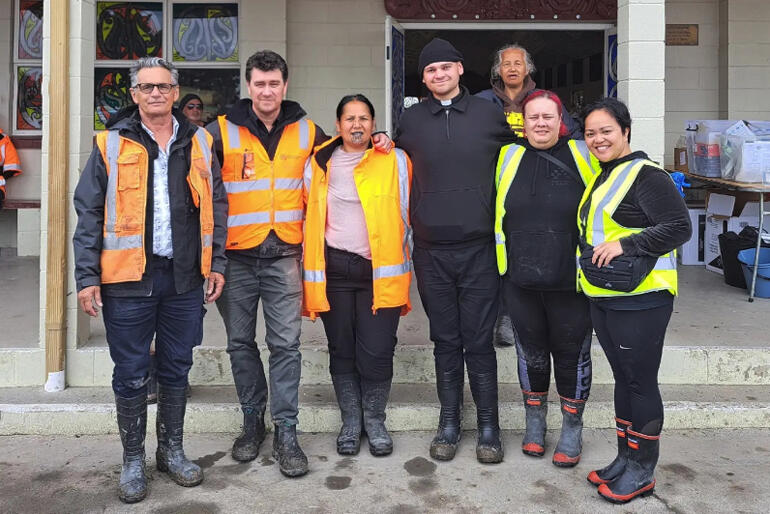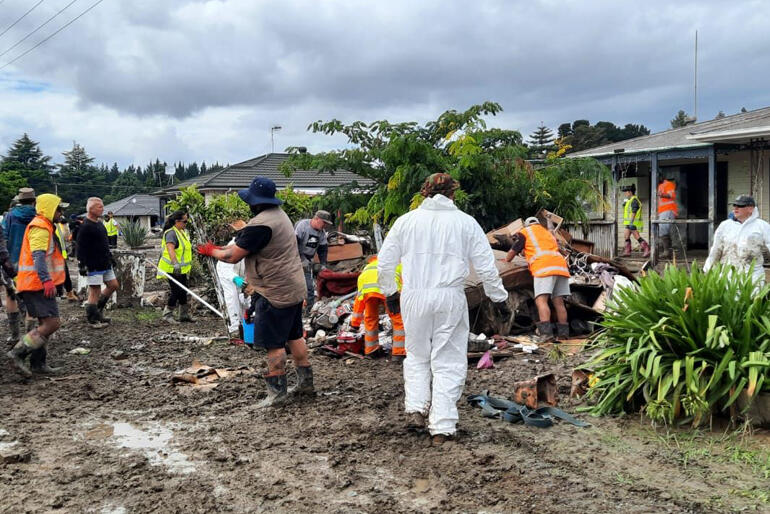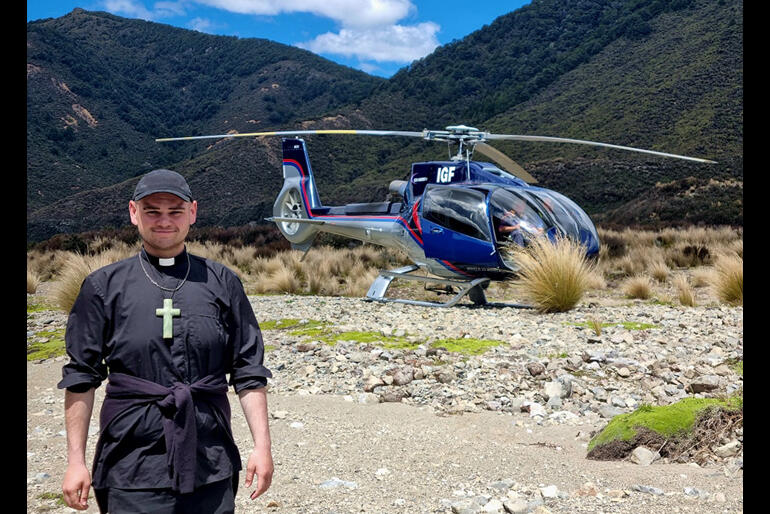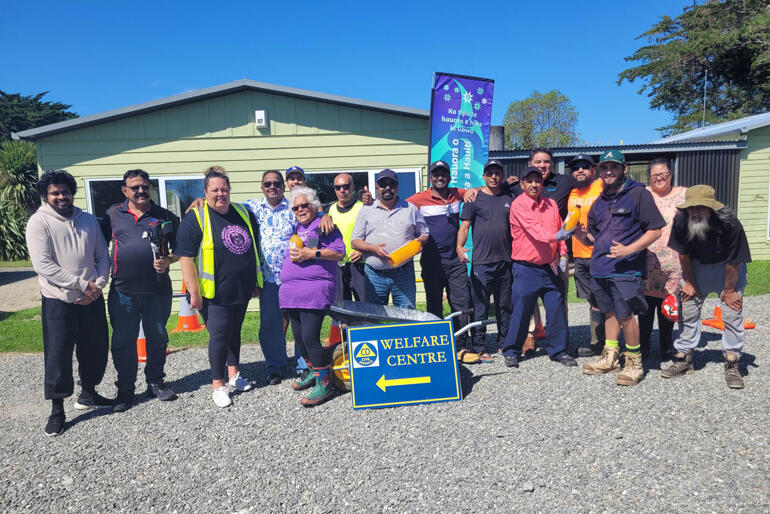












Now three months on from Cyclone Gabrielle, the first phase of Anglican support for Cyclone Gabrielle response on the East Coast is complete, as people across affected areas move on to their medium and long-term repair and prevention plans.
But back on February 16, when Anglican Church representatives gathered to form Hāpaitia – the Anglican Cyclone Response Group – the scale of destruction on the North Island’s East Coast was only beginning to become apparent.
While Te Pihopatanga o Te Tairāwhiti and the Diocese of Waiapu were still in the “power out” zone, unable to contact worried whānau or connect with the rest of the Church, Archbishop Don Tamihere, his staff and the Pihopatanga o Te Tairāwhiti team were quickly involved in emergency response.
Meanwhile, downed bridges and slip-torn roads prevented Bishop of Waiapu Andrew Hedge returning to his Napier diocesan base, so he stepped up in his St John Ambulance Officer role, joining medical teams in the emergency phase.
With the Pihopatanga’s Gisborne office staff badly affected by the Cyclone, the Waiapu Diocesan office soon transformed into a control centre for Anglican Cyclone response across the region, as registrar Colleen Kaye, Anglican Care Waiapu CEO Lucy Laitinen and their staff managed logistics, funding transfers, reporting and responding to requests for emergency help.
Also in the thick of response were Pihopatanga o Aotearoa staff and more than fifty non-stipendiary minita-a-iwi across Tairāwhiti, some of whom were ministering to others’ needs as they coped in homes with blown out windows, inundated sections or living in emergency accommodation themselves.
When St John’s College Trust and Waiapu Anglican Social Services Trust pledged $350,000 for the battered Northern and East Coast regions through Hāpaitia, at first the Church struggled to get help into the worst-affected zones.
Pihopatanga staff were blocked by humble replies from almost every minita they approached: “We’re fine, don’t worry about us, there are others who are worse off.”
So knowing those answers said more about the minita’s character than their true needs, Te Pihopatanga o Te Tairāwhiti proposed a blanket response, issuing a $1000 Cyclone response cash grant to 62 minita-a-iwi, empowering them to ease the burden on those in their care.
These grants put a dent in first round Cyclone costs: clean-up fees for silt-filled homes or sections, hundreds spent catering for houseloads of displaced friends and relatives, flights to get urgent medical care, fuel vouchers to run generators or carry out life and ministry along detour-extended routes.
As Mihinare whānau, minita and leaders mucked in with marae and iwi emergency centres and services, it soon became clear that iwi responses were where the Church’s support would go the furthest, the fastest.
Archbishop Don reminded Hāpaitia that in Tairāwhiti, they don’t draw boundaries between Te Hāhi Mihinare (the Māori Anglican Church) and the Iwi at times like this.
“We are one and the same people. For Mihinare, we are iwi(tribe) and we are church. We make no distinction. All of these marae-based responses have Mihinare minita and whānau at the heart of their operations, supporting the response and in many cases leading it.”
“Many of these marae we are supporting are centres for whakapono and karakia as well - many have whare karakia, others don’t, some wharenui host mihinare altars where worship is regularly held, and all of them are primary centres for ministry and service to our people.”
As Mihinare leaders identified where outstanding care was being delivered, Hāpaitia sent emergency grants to support six marae emergency response centres at: Te Poho o Rawiri Marae, Omahu Marae, Ohinewaiapu Marae, Tuatini Marae, Waipatu Marae and Waiparapara Marae.
The Anglican Church also backed three iwi providing a wide range of social services for Cyclone-affected whānau: Te Runanganui o Turanganui-a-Kiwa, Te Runanganui o Ngāti Porou and Ngāti Kahungunu Iwi Inc. all of whose social services arms were meeting urgent needs of people not receiving help in the Government-funded response.
Meanwhile in the Diocese of Waiapu, at Napier’s Taradale Anglican parish, Vicar Rev Alan Burnett had joined the early response, sourcing a generator to turn the church hall into an emergency drop-in centre. There Taradale parishioners offered home-cooked meals, and the chance for locals without power to charge their devices or use the hall’s hot showers.
As Alan travelled his parish bounds looking for ways to help, he found the small rural settlement of Pakowhai isolated from help in the Cyclone’s aftermath.
Looking ahead to avoid the same problem in future events, he and Pakowhai School Principal Tim Race decided to set up Pakowhai Community Trust, hosted by the parish to act as a first resource for local response in any future events, with Hāpaitia as one of the earliest contributors.
While Hāpaitia worked to direct money and spiritual resources where needed, Anglican churches and schools from around the country were clamouring to offer practical help.
The Diocese of Wellington offered silt-shovelling volunteer teams of six, which travelled in two different crews to Hawke’s Bay, ready to put their backs into any kind of work that local responders identified would help.
When Wellington’s teams departed Omahu marae, Archbishop Don reported to Hāpaitia that the hapu’s emergency centre leaders had welcomed their servanthood.
Later a group of students from Waikato University led by Waiapu Anglican Caitlin Hedge did the same, getting on the end of shovels as part of clean-ups guided by leaders at Waiohiki Marae.
In Gisborne, Tairawhiti’s own social services provider Te Aka Ora Charitable Trust led by CEO Joleen Perry, were among the first who turned out to support Te Karaka community with cooking for their emergency response centre, which ran for thirteen days at Te Karaka Area School.
During the storm, Joleen had been amongst the 500 people who evacuated onto two hills above Te Karaka, remaining there for 27 hours as the Waipaoa River flooded homes and severely damaged Rangatira Marae.
Kisa Tamihere, who is married to Archbishop Don, provided additional support to the Te Aka Ora team, running errands to and from Gisborne and Te Karaka and buying resources as needed. At Archbishop Don’s recommendation, a Hāpaitia grant contributed follow-up funds to uphold Te Karaka’s community response.
This Church also supported Te Whare Hauora o Te Aitanga a Hauiti in Tolaga Bay, helping to resource its work operating a welfare centre at its Health Centre offices. The Church’s grant supported Te Whare Hauora as its team provided essential food and clothing to affected whānau in the immediate aftermath of the Cyclone and installed a Starlink internet connection for their cut-off community.
The Anglican Church’s largest single donation to the Cyclone response effort went towards the marae-based Cyclone response at Omahu Marae where St John’s Anglican Church and cemetery stand.
There the flooding Ngaruroro River burst its banks sending a deluge of water and silt through dozens of homes and properties leaving the township of Omahu devastated.
Then as the floodwaters receded, Omahu leaders found the river’s torrent had unearthed koiwi (human bones) adding to the trauma of the event. That’s when they called for Rev Zhane Tahau Whelan, Māori Anglican priest and son of the Omahu hapu, to lead them in prayers and help calm the spiritual unrest.
Some days later, Rev Zhane joined iwi leaders on board a six-hour helicopter flight, where he recited karakia to bless the bounds of the hundreds of kilometres long Ngāti Kahungungu tribal area affected by the storms.
As Rev Zhane supported his hapu on the spiritual side, the Omahu marae community was mobilising its kitchens and supply lines to churn out hundreds of meals every day, feeding their town hard at work in the Cyclone’s aftermath.
The $40K fund Hāpaitia approved for hard-hit Omahu marae went to buy essential food, stores and fuel to keep the marae’s community lifeline going on generator power. Also at Omahu, Anglican Missions’ development and media staff visited and installed a Starlink system to get the Omahu community back online.
Finally, the Church responded to calls for expert pastoral and psychological support for people serving at the frontline of Cyclone response and those struggling with loss. Hāpaitia joined with Waiapu Anglican Social Services Trust to fund three visiting trauma specialists, psychologists Clive Banks and Richard Sawrey and awhi whānau expert Hera Clarke to work with affected people in the Diocese of Waiapu and Tairāwhiti.
The three counsellors each spent a few days in the hard-hit regions of Tairāwhiti and Hawke’s Bay, spending time with clergy, staff and other heavily-impacted people to help them navigate the mental health challenges of trauma events and find strategies for resilience.
Cyclone Gabrielle Appeal still open
Following the first round of Anglican Cyclone response, Hāpaitia and Anglican Missions opened the Cyclone Gabrielle Appeal to expand this Church’s support for Cyclone response beyond the $380,000 in initial grants.
Anglican Missions has now collected a further $380,000 in Cyclone response funds, and around $90K of that figure has gone out to projects in the affected regions in mostly $10K grants, while more funding is available for Cyclone affected communities.
Right now, Cyclone Gabrielle Appeal funding remains open for Expressions of Interest.
Hāpaitia considers projects that address either current or longer term needs, including work to future proof vulnerable communities, such as hiring experts to assess at risk marae and church buildings, medium term Cyclone repairs and provisions for people still coping with inadequate conditions.
Anglican Missions is now receiving expressions of interest for grant funding of up to $10,000. Contact Anglican Missions on 04 473 5172 or email info@anglicanmissions.org.nz with your proposal idea. More information on this process can be found at https://www.hapaitia.org.nz/tinana

















Comments
Log in or create a user account to comment.